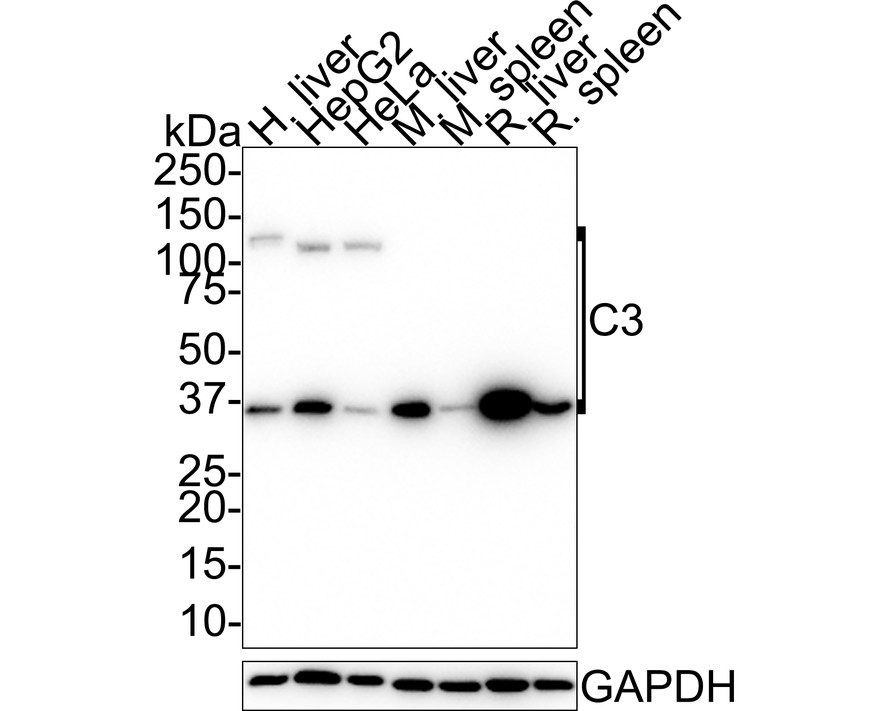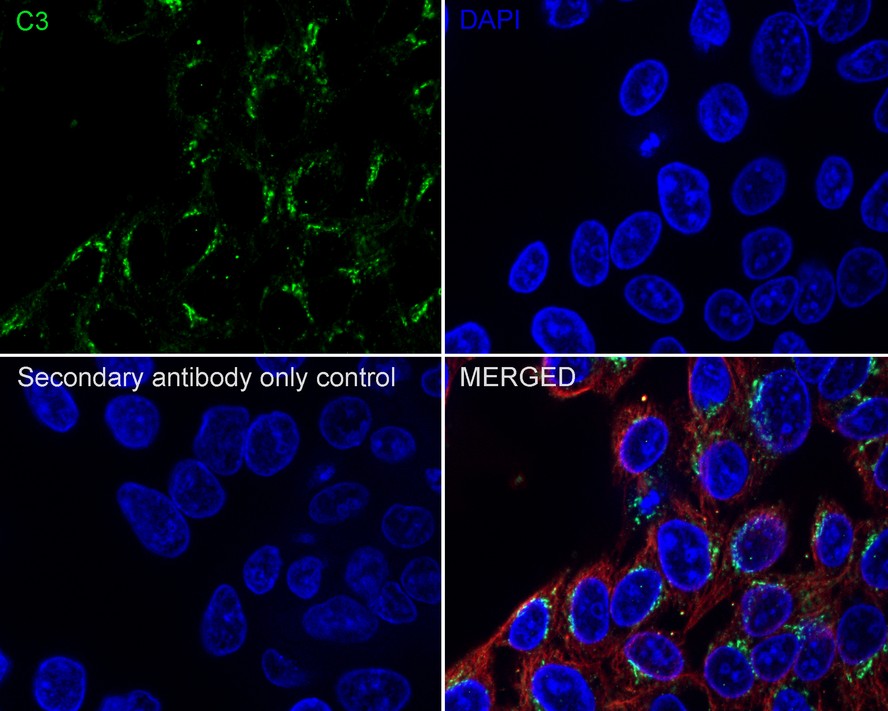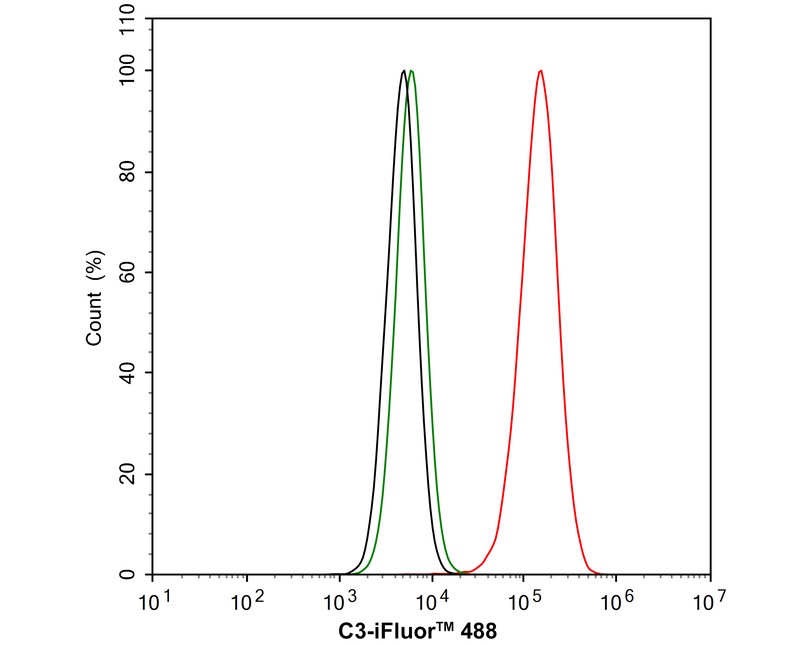Complement C3 Recombinant Rabbit Monoclonal Antibody [JF10-30]

cat.: ET1702-99
| Product Type: | Recombinant Rabbit monoclonal IgG, primary antibodies |
|---|---|
| Species reactivity: | Human, Mouse, Rat |
| Applications: | WB, IF-Cell, FC |
| Clonality: | Monoclonal |
| Clone number: | JF10-30 |
| Form: | Liquid |
| Storage condition: | Shipped at 4℃. Store at +4℃ short term (1-2 weeks). It is recommended to aliquot into single-use upon delivery. Store at -20℃ long term. |
| Storage buffer: | 1*TBS (pH7.4), 0.05% BSA, 40% Glycerol. Preservative: 0.05% Sodium Azide. |
| Concentration: | 1ug/ul |
| Purification: | Protein A affinity purified. |
| Molecular weight: | Predicted band size: 187 kDa |
| Isotype: | IgG |
| Immunogen: | Synthetic peptide within Human C3 aa 1,210-1,248 / 1,663. |
| Positive control: | Human liver tissue lysate, HepG2 cell lysate, HeLa cell lysate, Mouse liver tissue lysate, Mouse spleen tissue lysate, Rat liver tissue lysate, Rat spleen tissue lysate, HepG2. |
| Subcellular location: | Secreted. |
| Recommended Dilutions:
WB IF-Cell FC |
1:1,000 1:100 1:1,000 |
| Uniprot #: | SwissProt: P01024 Human | P01027 Mouse | P01026 Rat |
| Alternative names: | Acylation stimulating protein cleavage product AHUS5 ARMD9 ASP C3 and PZP like alpha 2 macroglobulin domain containing protein 1 C3 and PZP-like alpha-2-macroglobulin domain-containing protein 1 C3 CO3_HUMAN Complement C3 Complement C3c alpha' chain fragment 2 Complement component 3 Complement factor 3 CPAMD1 HEL S 62p |
Images

|
Fig1:
Western blot analysis of Complement C3 on different lysates with Rabbit anti-Complement C3 antibody (ET1702-99) at 1/1,000 dilution. Lane 1: Human liver tissue lysate Lane 2: HepG2 cell lysate Lane 3: HeLa cell lysate Lane 4: Mouse liver tissue lysate Lane 5: Mouse spleen tissue lysate Lane 6: Rat liver tissue lysate Lane 7: Rat spleen tissue lysate Lysates/proteins at 30 µg/Lane. Predicted band size: 187 kDa Observed band size: 108/37 kDa Exposure time: 1 minute; 4-20% SDS-PAGE gel. Proteins were transferred to a PVDF membrane and blocked with 5% NFDM/TBST for 1 hour at room temperature. The primary antibody (ET1702-99) at 1/1,000 dilution was used in 5% NFDM/TBST at 4℃ overnight. Goat Anti-Rabbit IgG - HRP Secondary Antibody (HA1001) at 1/50,000 dilution was used for 1 hour at room temperature. |

|
Fig2:
Immunocytochemistry analysis of HepG2 cells labeling Complement C3 with Rabbit anti-Complement C3 antibody (ET1702-99) at 1/100 dilution. Cells were fixed in 100% precooled methanol for 5 minutes at room temperature, then blocked with 1% BSA in 10% negative goat serum for 1 hour at room temperature. Cells were then incubated with Rabbit anti-Complement C3 antibody (ET1702-99) at 1/100 dilution in 1% BSA in PBST overnight at 4 ℃. Goat Anti-Rabbit IgG H&L (iFluor™ 488, HA1121) was used as the secondary antibody at 1/1,000 dilution. PBS instead of the primary antibody was used as the secondary antibody only control. Nuclear DNA was labelled in blue with DAPI. Beta tubulin (M1305-2, red) was stained at 1/100 dilution overnight at +4℃. Goat Anti-Mouse IgG H&L (iFluor™ 594, HA1126) was used as the secondary antibody at 1/1,000 dilution. |

|
Fig3:
Flow cytometric analysis of HepG2 cells labeling Complement C3. Cells were fixed and permeabilized. Then stained with the primary antibody (ET1702-99, 1μg/mL) (red) compared with Rabbit IgG Isotype Control (green). After incubation of the primary antibody at +4℃ for an hour, the cells were stained with a iFluor™ 488 conjugate-Goat anti-Rabbit IgG Secondary antibody (HA1121) at 1/1,000 dilution for 30 minutes at +4℃. Unlabelled sample was used as a control (cells without incubation with primary antibody; black). |
Note: All products are “FOR RESEARCH USE ONLY AND ARE NOT INTENDED FOR DIAGNOSTIC OR THERAPEUTIC USE”.